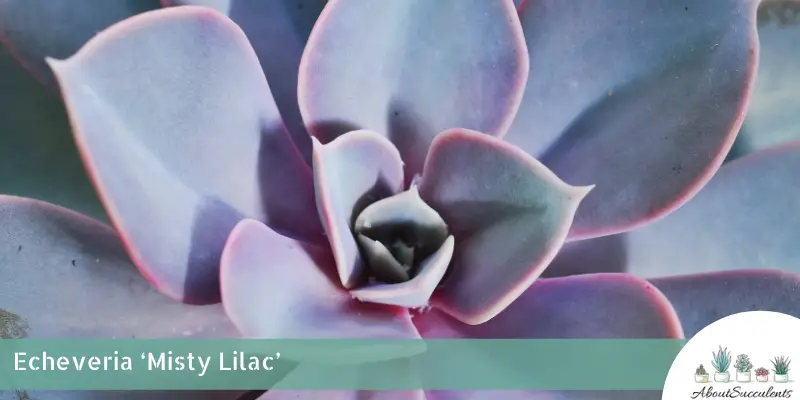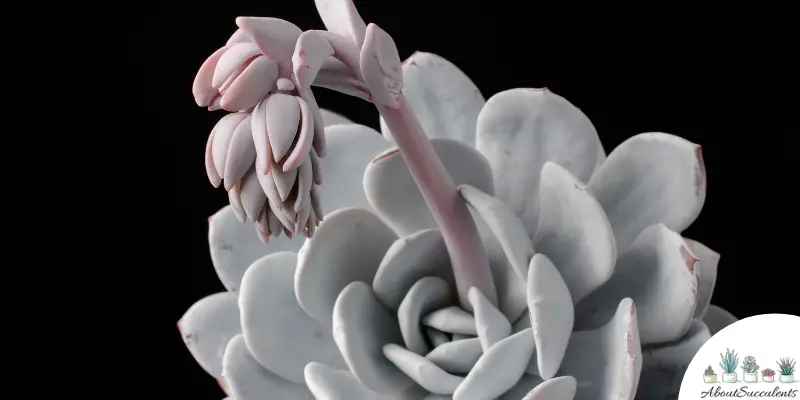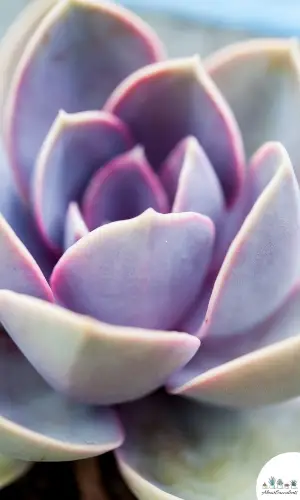
Echeveria “Misty Lilac” is a succulent that has a spellbinding attractiveness about it. One might think that a more appropriate nickname would be “Mystic Lilac”.
Typical of echeverias, Misty Lilac forms a large, purple-colored rosette that’s easily distinguished by its triangle-shaped leaves which curl up and give the succulent a look that’s uniquely its own.
Echeveria Misty Lilac only grows up to 12-inches (30.48cm) tall and 18-inches (45.72cm) wide. If you want Misty Lilac to attain its maximum height, plant it outdoors where it can get more sun, better nutrients in its soil, and more space to grow.
In the springtime, you’ll be greeted by charming orange-yellow flowers that go perfectly well with the royal purple color of the rosette. Echeveria Misty Lilac is native to Mexico and Argentina and is a member of the Crassulaceae family.
General Information
Also known as: Misty Lilac
Plant Family: Crassulaceae
Origin: Mexico and Argentina
Height: 12-inches (30.48cm)
Exposure: Full sun or partial shade; avoid the afternoon sun
Water Needs: Follow the Soak and Dry method and only water the soil when it’s dry.
Soil Type: Cactus mix or regular succulent blend combined with perlite, pumice, coarse sand, or lava rock to improve drainage.
Soil pH: 6.0 to 7.0
How to Grow and Care for Echeveria “Misty Lilac”

With a little bit of love and care, Echeveria Misty Lilac will remain healthy and beautiful for a long time. Whether you decide to grow this charming succulent in the garden or as an indoor plant, you won’t spend a lot of time attending to its lighting, watering, and soil needs.
If you live in a region where the temperature might fall below 30° F (-1.1° C), we recommend planting Misty Lilac in a pot that can be moved indoors right away.
While durable to the elements, Misty Lilac isn’t cold-hardy and won’t survive frosty conditions.
Sunlight
We know that plants like Echeveria Misty Lilac need the sun to help it produce food. But Misty Lilac also needs the rays of the sun to help it achieve the full beauty of its colors.
If you prefer Misty Lilac as a garden succulent, plant it in a location that receives 6 hours of partial to direct sunlight. Again, full sun would be better to bring out the captivating colors of the succulent.
Keep in mind to avoid the harsh rays of the afternoon sun as these can burn Echeveria’s leaves.
As an indoor succulent plant, place the pot near a window that gets 6 hours of partial sun. If this isn’t possible, put Misty Lilac under a Grow Light for up to 6 hours every day.
Sunlight is crucial to maintaining the health of Echeveria Misty Lilac. If the succulent doesn’t receive enough sunlight, etiolation will take place.
Etiolation is the process whereby the leaves stretch out as if they were looking for the sun. The leaves wither, dry out, and eventually die. If you notice etiolation taking place, you can remedy the situation simply by gradually exposing Misty Lilac to sunlight.
Watering

You might have come across movies where there are scenes with people seemingly watering their succulents every day – and on their leaves. No to both counts!
Overwatering Echeveria Misty Lilac is the most harmful thing you can do. If the soil is kept moist for a long period of time, it will develop bacteria and fungi. The roots get immersed in water and their cells will rupture leaving the succulent exposed to bacterial and fungal contamination.
Before giving the soil water, check its level of dryness by inserting a stick an inch deep. Pull out the stick and if the end feels dry, prepare to give the soil a thorough soaking. This is called the “Soak and Dry” method of watering.
In the summertime, you might find yourself watering the soil every seven to 10 days. During winter, the soil will stay moist longer so watering will be less frequent. Sometimes, you might only need to water the soil once a month.
Pot and Soil
Growing Echeveria Misty Lilac in a pot is a good idea especially if you live in an area that experiences frosty weather. Choose a pot that supports proper soil aeration to dry it out as soon as possible. The best choices are pots made of unglazed ceramic and terracotta.
The pot should be slightly bigger than the succulent plant to allow its roots to grow comfortably and not get entangled. The soil needs space to provide much-needed air circulation.
Lastly, make sure the pot has a drain hole at the bottom to filter out excess water from the soil. It should have a mesh net cover to prevent soil from falling out.
When it comes to soil, the priority remains drainage. We can’t stress enough the importance of drying out the soil and avoiding root rot. Plant Echeveria Misty Lilac in well-draining cactus soil or a commercial succulent mix. Add materials that improve drainage such as perlite, pumice, coarse sand, and lava rocks.
How to Propagate Echeveria “Misty Lilac”
Fall in love with Echeveria Misty Lilac several times over by adding more to your collection. There are 3 ways to propagate the species: Leaves, stem cuttings, and offsets.
Method 1: Leaves
Step 1: Choose healthy leaves preferably close to the main plant.
Step 2: Perform a slow and clean twist and pull to remove the leaf from the stem. Take great care that no part of the leaf is left on the stem or successful propagation might not take place.
Step 3: Place the leaves in a dry area and allow it 2 to 4 days to develop hard calluses.
Step 4: When the leaves have hardened from the growth of calluses, place it on top of well-draining soil.
Step 5: Lightly water the soil and position the pot in an area that gets 6 hours of partial sunlight every day.
Step 6: Cut down the watering to only whenever the soil is dry and the leaves have taken root.
Method 2: Stem Cuttings
Step 1: Cut off a healthy stem with sterilized pair of garden shears or a sharpened knife.
Step 2: Place the stem cuttings in a dry area and allow it to grow calluses over a period of 2 to 4 days.
Step 3: Once the calluses have formed, place the stem cuttings on top of well-draining soil.
Step 4: Lightly water the soil and place the pot in an area that receives partial sunlight for up to 6 hours per day.
Step 5: Limit the frequency of watering to only whenever the soil is 100% dry once the roots have taken hold.
Method 3: Offsets
Step 1: Echeveria Misty Lilac will produce offsets or pups that will grow from near the base of the plant.
Step 2: Gently pull out the offsets from the soil.
Step 3: Allow the offsets to develop calluses which might take 2 to 4 days.
Step 4: Plant the hardened offsets in a pot filled with well-draining soil.
Step 5: Water the soil only when you’ve tested and confirmed its level of dryness.
Frequently Asked Questions
Is Echeveria “Misty Lilac” Toxic For Cats And Dogs?
Echeveria Misty Lilac doesn’t appear on the list of plants that are toxic to cats and dogs on the website of the American Society for the Prevention of Cruelty to Animals (ASPCA).
Why Is My Echeveria “Misty Lilac” Dying?
If you suspect that your Echeveria Misty Lilac is close to dying, it might either be because of 4 factors: Overwatering, Underwatering, Lack of Sunlight, and Pest Infestation.
Overwatering
We discussed this in-depth earlier. You can tell right away that your plant has been contaminated by fungal infection if you notice discoloration on its leaves and stems.
The first thing you have to do is to cut off the infected sections right away with a sterilized and sharpened knife or garden shears. Make sure to disinfect the cutting tool with 70% isopropyl alcohol after every cut.
Remove the plant from its soil and cut off all infected roots. Allow the plant to dry out while you prepare the new pot with fresh soil. Replant Misty Lilac and keep track of its watering schedule.
Underwatering
Although neglect is good, not giving Misty Lilac water when the soil has completely dried out will not be good for its health. Plants need water to pull nutrients from the soil.
If you notice the leaves withering out, give the soil a thorough soaking. Resist the urge to give the soil more water than it needs. Once you see the water dripping out of the drain hole, stop. Your plant will recover soon enough.
Lack of Sunlight
If etiolation takes place, all you have to do is to give your plant gradual exposure. Don’t expose it to full sunlight right away. Start out with partial sunlight for a few hours every day. When you see the leaves start to perk up, give it a few hours of direct morning sunlight.
Pest Infestation
Pests such as mealybugs, aphids, and red spiders will try to make Echeveria Misty Lilac their home because they love to drink the nutritious sap.
Spray Misty Lilac with natural neem oil to keep pests away.
Yes, Echeveria Misty Lilac will bloom orange-yellow flowers In the springtime.
Last Updated on June 9, 2022 by Sofia Lara